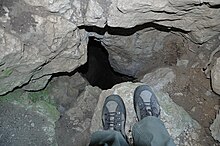

Karst well ( natural well ) - a karst relief shape is usually rounded, irregular, cylindrical or fractured up to 10 m in diameter, 20–60 m deep, with vertical or nearly sheer walls, arising from leaching of rocks with percolating waters. According to I. S. Shchukin , karst wells are formed as a result of the failure of the vault of the underground cavity, or they are not functioning ponor . In essence, a karst well is a narrow and relatively deep vertical cave of karst origin . Similar relief forms having more than 10 m in diameter and tens and hundreds of meters in depth are called karst mines .
Wells are one of the most common obstacles in caves. Currently, they are overcome, as a rule, by moving along the rope with the help of special equipment and using special skills. The most common in vertical caving technique single rope (SRT). Most of the deep caves are a series of dozens of wells, connected by passages of different length and morphology. The largest of the known continuous wells is located in the Vrtoglavitsa Cave ( Julian Alps , Slovenia ) and reaches a depth of 603 m [1] .
See also
- Karst
- Karst funnel
- Karst mine
- Cave
- Pitch
Notes
- ↑ The Worlds Great Vertical Pits (Eng.)
Literature
- Timofeev D.A., Dublyansky V.N., Kiknadze T.Z. Terminology karst. M .: "Science", 1991.
- Schukin I.S. The four-language encyclopedic dictionary of terms in physical geography. M .: Soviet Encyclopedia, 1980.